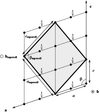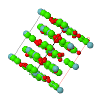issue contents
April 2009 issue

Cover illustration: Though cyclohexanol is a simple compound it has a rich phase diversity at low temperature. It forms a disordered glassy phase on cooling, but this can be transformed into ordered phases (II), (III) and the metastable (III'), which all have different hydrogen-bonding motifs. The series of transitions is attributable to the conformational flexibility of the hydroxyl group [Ibberson et al. (2008). Acta Cryst. B64, 573-582].
feature articles
Download citation


Download citation


Free 

The findings of the fourth blind test of crystal structure prediction, which have demonstrated important progress in computational methods, are presented and discussed.
research papers
Download citation


Download citation


The crystal structures of the Ln3Ag1 − δGeS7 (Ln = La–Nd, Sm, Gd–Er, Y; δ = 0.11–0.50) compounds were determined. Structural relationships, stereochemistry and silver-ion motion in the Ln3M1 − δTX7 compounds are discussed.
The symmetry and transformation behaviour of ABX3 perovskites with Jahn–Teller and octahedral tilting transitions are analysed using group theory and Landau theory. Selected well known perovskite structures occur among the structure types predicted on this basis, but there are also many more which have not yet been reported. General expressions are given for the lattice geometry of the Jahn–Teller/tilted structures, and symmetry hierarchies are derived to describe the possible phase transitions which can occur between them.
The thermodynamic and structural evolution of selected vanadate, manganite, aluminate and cobaltate perovskites which undergo both octahedral tilting transitions and Jahn–Teller cooperative distortion transitions have been determined from observed variations in lattice parameters. Analysis of the lattice-parameter data in terms of symmetry-adapted strains confirms the importance of strain/order-parameter coupling and reveals the separate evolution of Jahn–Teller and tilting components in these materials.
Download citation


Download citation


A phase found as a minor second phase in zinc oxide-based varistor materials doped with vanadium oxide and manganese oxide is shown to be the L phase in the pseudobinary Mn2V2O7–Zn2V2O7 system. Rietveld refinement of the L phase shows that it has a thortveitite supercell structure.
Download citation


Download citation


Compounds in the family Ca1 − xSrxTeO3 crystallize in at least five different structure types. Whereas the structures of β-, β′-, γ-CaTeO and the solid solutions Ca0.55Sr0.45O3 and Ca0.77Sr0.33TeO3 are closely related, the thermodynamically stable α-CaTeO3 shows unique structural features.
and the solid solutions Ca0.55Sr0.45O3 and Ca0.77Sr0.33TeO3 are closely related, the thermodynamically stable α-CaTeO3 shows unique structural features.
Download citation


Download citation


The synthesis and characterization of a new polymorph of the complex [AgI{P(4-MeC6H4)3}3] is described. The molecular structure was determined by single-crystal X-ray diffraction. The current polymorph was compared with a previously reported polymorph using r.m.s. overlay as well as half-normal probability plot analysis.
Download citation


Download citation


The crystal structure of the α phase of this azo pigment was investigated by various methods and finally solved from X-ray powder data. Pair-distribution-function analysis was used to obtain structural information on the nanocrystalline β phase.
Download citation


Download citation


The first six structures of commercially produced benzimidazolone pigments were solved from laboratory powder diffraction data. All six structures are very different but have strong intermolecular hydrogen bonding in common.
Download citation


Download citation


Laboratory X-ray powder data were sufficient to solve the crystal structures of Ca(C16H10Cl2N4O7S2)·H2O (α-P.Y. 183) and Ca(C17H13ClN4O7S2)·3H2O (β-P.Y. 191) using real-space and Rietveld methods. Structures of other phases and solvates were determined from Rietveld refinement on isostructural compounds or from single-crystal data.
Download citation


Download citation


A ten-membered N-acetyl macrocyclic amide crystallizes as a solid solution of racemic columnar assemblies consisting of alternating enantiomers in a stacked-cup array, each as a chloroform monosolvate, but with a random distribution of the columns within the crystal leading to whole-molecule disorder within the crystal.
Download citation


Download citation


Experimental charge-density studies have been used to obtain insights into the intra- and intermolecular interactions present in coumarin-3-carboxylic acid and trans-cinnamic acid, both of which undergo [2 + 2] cycloaddition reactions upon irradiation.
Download citation


Download citation


The crystal structures of diacetates of 6-s-cis and 6-s-trans astaxanthin, and the diols 7,8-didehydroastaxanthin and 7,8,7′,8′-tetradehydroastaxanthin provide an ensemble of end-ring conformations which are compared with those of unbound astaxanthin and the protein-bound astaxanthin in lobster β-crustacyanin. The effect of these end-ring conformations on the colour of the crystals and their solid- and solution-state UV–vis spectra are discussed with reference to the large bathochromic shift seen between the unbound and protein-bound forms of astaxanthin.


 journal menu
journal menu






























